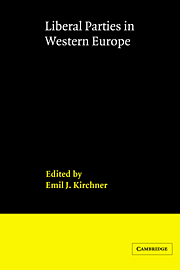Book contents
- Frontmatter
- Contents
- List of tables
- List of diagrams
- List of maps
- Notes on the contributors
- Preface
- 1 Introduction
- 2 Between left and right: the ambivalence of European liberalism
- 3 Two roads of Italian liberalism: the Partito Repubblicano Italiano (PRI) and the Partito Liberale Italiano (PLI)
- 4 The FDP in the Federal Republic of Germany: the requirements of survival and success
- 5 Great Britain — social liberalism reborn?
- 6 Liberalism in France
- 7 Liberal parties in the Netherlands
- 8 The Belgian liberal parties: economic radicals and social conservatives
- 9 The Freiheitliche Partei Österreichs: protest party or governing party?
- 10 The Swedish Liberal Party: The politics of unholy alliances
- 11 Liberalism in Denmark: agrarian, radical and still influential
- 12 The Norwegian Liberal Party: from political pioneer to political footnote
- 13 Liberal parties in Finland: from perennial coalition actors to an extra-parliamentary role
- 14 Liberal parties in Switzerland
- 15 The Luxemburg Liberal Party
- 16 Identifying liberal parties
- 17 Ambivalence revisited: an analysis of liberal party manifestos since 1945
- 18 Transnational links: the ELD and Liberal Party Group in the European Parliament
- 19 Western European liberal parties: developments since 1945 and prospects for the future
- Index of political parties
- General index
16 - Identifying liberal parties
Published online by Cambridge University Press: 16 November 2009
- Frontmatter
- Contents
- List of tables
- List of diagrams
- List of maps
- Notes on the contributors
- Preface
- 1 Introduction
- 2 Between left and right: the ambivalence of European liberalism
- 3 Two roads of Italian liberalism: the Partito Repubblicano Italiano (PRI) and the Partito Liberale Italiano (PLI)
- 4 The FDP in the Federal Republic of Germany: the requirements of survival and success
- 5 Great Britain — social liberalism reborn?
- 6 Liberalism in France
- 7 Liberal parties in the Netherlands
- 8 The Belgian liberal parties: economic radicals and social conservatives
- 9 The Freiheitliche Partei Österreichs: protest party or governing party?
- 10 The Swedish Liberal Party: The politics of unholy alliances
- 11 Liberalism in Denmark: agrarian, radical and still influential
- 12 The Norwegian Liberal Party: from political pioneer to political footnote
- 13 Liberal parties in Finland: from perennial coalition actors to an extra-parliamentary role
- 14 Liberal parties in Switzerland
- 15 The Luxemburg Liberal Party
- 16 Identifying liberal parties
- 17 Ambivalence revisited: an analysis of liberal party manifestos since 1945
- 18 Transnational links: the ELD and Liberal Party Group in the European Parliament
- 19 Western European liberal parties: developments since 1945 and prospects for the future
- Index of political parties
- General index
Summary
introduction
When the president of the European Parliament was elected in January 1987, the Liberal group voted for the left-wing Radical Marco Panella on the first ballot and for Sir Henry Plumb, a Conservative, on the second. The group claimed that ‘by shifting en bloc from Panella to Plumb’ [it] ‘thereby illustrated the deep unity which exists – in their diversity – between the European Liberals’. Others might consider that this behaviour illustrated the lack of political coherence amongst the European parties which claim to be liberal. Liberal parties thus confront us with a major problem of classification and of analysis. In simple terms, the problem arises because the Liberal family itself asserts that it exists; yet even the most superficial glance at the Liberal group in the European Parliament or at the Liberal International finds it to be a most heterogeneous collection, embracing elements that on close inspection strike the political scientist as being surprising candidates for inclusion. This problem is exacerbated by the fact that political scientists have, until now, tended to focus only on the major party families and have not yet given much attention to the smaller party families. The problem is, in fact, very complex and can be approached at several different levels.
At the intellectual level, attempting to identify liberal parties should produce important lessons for the study of parties and party systems.
- Type
- Chapter
- Information
- Liberal Parties in Western Europe , pp. 396 - 435Publisher: Cambridge University PressPrint publication year: 1988
- 4
- Cited by



